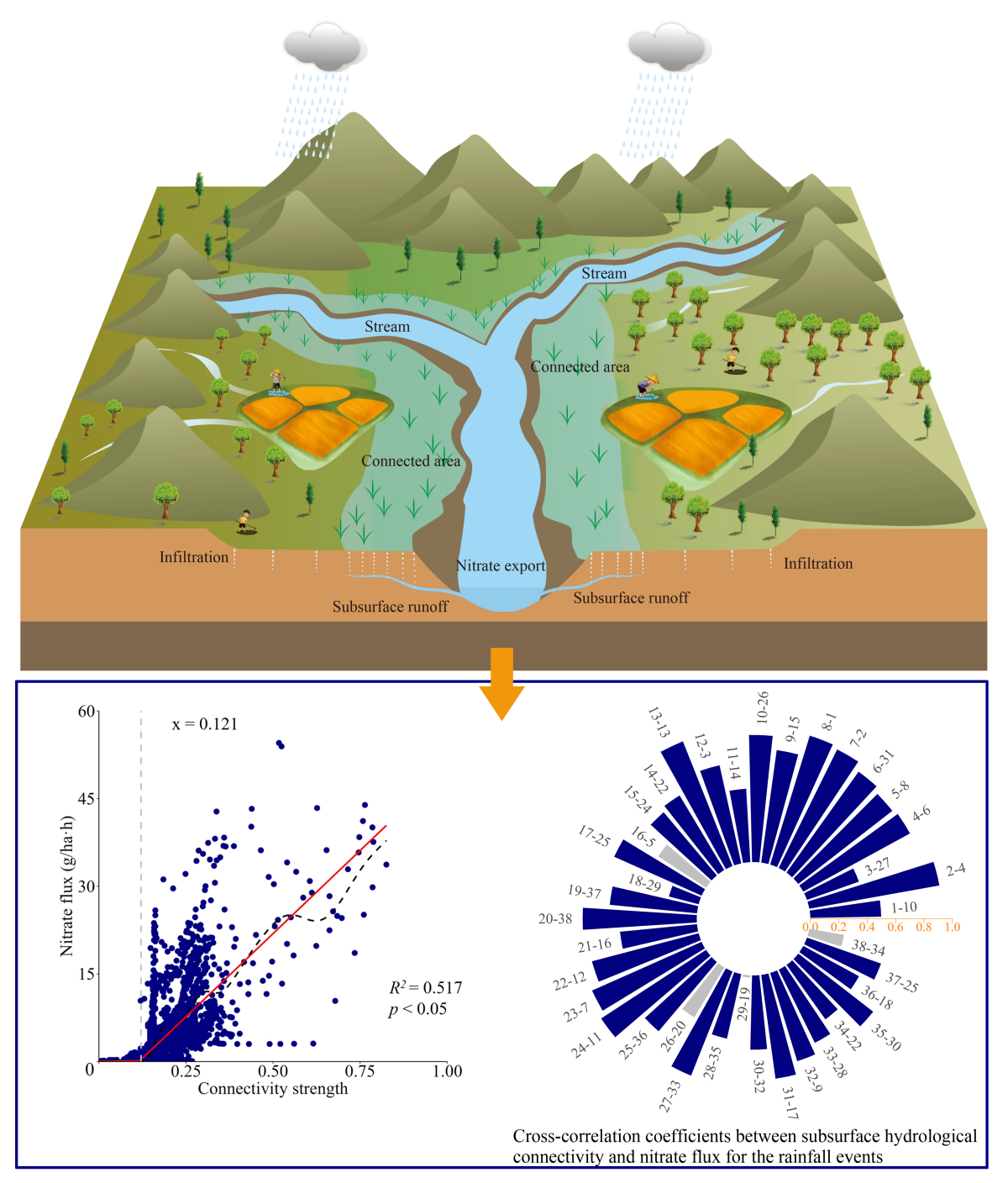近日,我校水土流失与生态调控创新团队在流域硝酸盐输移方面取得进展,并在Water Research发表了题为“Subsurface hydrological connectivity controls nitrate export flux in a hilly catchment”的学术论文。
硝酸盐是重要的面源污染物,对水环境质量与人类健康造成严重威胁。径流是硝酸盐迁移的主要载体,在地下水发育良好的亚热带丘陵流域,地下径流对硝酸盐的输出贡献达80%以上。降雨过程硝酸盐能否随地下径流迁移至受纳水体主要取决于径流的畅通程度,即地下水文连通性。在弱降雨条件下,地下水文连通区域主要集中于河岸区,随降雨强度的增加,连通区域逐渐由河岸向山坡延伸。随连通区域土地利用、土壤、地形等环境条件的变化,径流硝酸盐的来源与浓度也呈现出复杂的动态变化。由于地下水文过程的隐蔽性,目前流域地下水文连通性的时空变化规律及其对硝酸盐输出的影响机制仍缺乏系统认知。
研究团队通过对流域浅层地下水位进行长达17个月的高频监测,阐明了降雨过程流域地下水文连通性的时空变化特征,明确了硝酸盐随降雨径流的输出模式与通量,量化了地下水文连通性与硝酸盐输出通量的非线性关系。结果表明:降雨过程流域大多数区域无法与溪流建立地下水文连通,其最大连通范围主要受控于降雨量,而平均连通强度主要取决于前期降雨条件。流域地下水文连通性与硝酸盐输出通量呈现明显的阈值关系,当地下水文连通强度超过0.121时,流域硝酸盐输出通量快速增加。此外,时间序列相似性分析表明,地下水文连通性对流域硝酸盐输出通量具有较强的控制作用,但这一控制作用并非是稳态的,它随降雨量和雨强呈幂函数增加。成果为科学认知流域硝酸盐的地下输移过程提供了理论依据。

流域地下水文连通性对硝酸盐输出的影响
我校肖海兵副教授为论文的第一作者,史志华教授为论文通讯作者。我校王玲副教授、赵劲松副教授、王剑博士后、中国科学院地理科学与资源研究所杨风亭副研究员、长江科学院水土保持研究所黄金权高工参与了研究。本研究得到了国家自然科学基金项目的资助。
【英文摘要】
Subsurface runoff represents the main pathway of nitrate transport in hilly catchments. The magnitude of nitrate export from a source area is closely related to subsurface hydrological connectivity, which refers to the linkage of separate regions of a catchment via subsurface runoff. However, understanding of how subsurface hydrological connectivity regulates catchment nitrate export remains insufficient. This study conducted high-frequency monitoring of shallow groundwater in a hilly catchment over 17 months. Subsurface hydrological connectivity of the catchment over 38 rainfall events was analyzed by combining topography-based upscaling of shallow groundwater and graph theory. Moreover, cross-correlation analysis was used to evaluate the time-series similarity between subsurface hydrological connectivity and nitrate flux during rainfall events. The results showed that the maximum subsurface hydrological connectivity during 32 out of 38 rainfall events was below 0.5. Although subsurface flow paths (i.e., the pathways of lateral subsurface runoff) exhibited clear dynamic extension and contraction during rainfall events, most areas in the catchment did not establish subsurface hydrological connectivity with the stream. The primary pattern of nitrate export was flushing (44.7%), followed by dilution (34.2%), and chemostatic behavior (21.1%). A threshold relationship between subsurface hydrological connectivity and nitrate flux was identified, with nitrate flux rapidly increasing after the subsurface connectivity strength exceeded 0.121. Moreover, the median value of cross-correlation coefficients reached 0.67, which indicated subsurface hydrological connectivity exerts a strong control on nitrate flux. However, this control effect is not constant and it increases with rainfall amount and intensity as a power function. The results of this study provide comprehensive insights into the subsurface hydrological control of catchment nitrate export.
